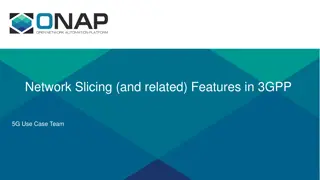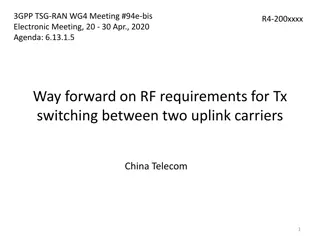Enhancing QoS Facility for Low-Latency High-Throughput Performance in IEEE 802.11 Networks
This proposal addresses the shortcomings in traffic classification and handling of uplink/downlink traffic in current IEEE 802.11 specifications, particularly in relation to low-latency traffic. It also highlights issues with the current EDCA mode in managing congestion and proposes high-level solut
5 views • 18 slides
IEEE 802.11-23/1874r0: Reverse TXOP Sharing for Improved Wireless Communication
This contribution presents the concept of Reverse TXOP Sharing in IEEE 802.11 networks, allowing non-AP STAs to share their TXOP with APs for efficient data transmission. The proposal addresses current limitations in TXOP utilization and offers a mechanism for enhanced Downlink and Uplink traffic ma
4 views • 11 slides
Way Forward for Uplink Full Power Transmission in 3GPP TSG-RAN.WG4#95-e Meeting
Discusses the implementation guidelines and performance requirements for Uplink Full Power Transmission (ULFPTx) features in 3GPP meetings, focusing on Mode-1 UE support, TX antenna connectors, SRS resource transmission methods, and Transparent TxD applicability, emphasizing the existing UE features
0 views • 8 slides
Way Forward on Transparent Tx Diversity in 3GPP.TSG-RAN.WG4#94-e-Bis Meeting R4-2005652
The meeting discusses the implementation of transparent Tx Diversity for uplink full power transmission in the context of 3GPP specifications for FR1 in Release 16 and beyond. It outlines the necessary changes needed to allow UE behavior of transparent Tx Diversity, test case adaptations, power scal
1 views • 11 slides
Discussion on FDM Operation for SL and Uu in Licensed Band at 3GPP TSG-RAN WG4#98-e Meeting
The 3GPP TSG-RAN WG4#98-e meeting discussed introducing Frequency Division Multiplexing (FDM) operation for Uplink (UL) and Secondary Link (SL) in licensed bands. Topics included frequency separation, power control, RF architecture, and intra-band Carrier Aggregation (CA). Options were considered fo
0 views • 10 slides
3GPP TSG-RAN-WG4 Meeting #98-bis-e Electronic Meeting Summary
The 3GPP TSG-RAN-WG4 Meeting #98-bis-e discussed Channel Modeling for FR2 in the context of NR HST enhancements. Issues related to link budget evaluation and performance requirements were covered. Discussions included channel models for Scenario-B, demodulation performance requirements, and uplink c
0 views • 10 slides
DetNet 3GPP SA2 Offline Discussion Summary
The DetNet 3GPP SA2 offline discussion held by Ericsson in November 2022 covers several outstanding issues related to DetNet architecture, including support for an optional NEF, uplink routing information reporting, and the role of NEF in protocol conversion. Three alternative approaches for NEF imp
0 views • 12 slides
Overview of Network Slicing and Features in 3GPP 5G Use Case Team
Network slicing in 3GPP's 5G architecture allows for the creation of logical networks with specific capabilities. The end-to-end slicing process involves various network functions like Access and Mobility Management Function (AMF), Session Management Function (SMF), and User Plane Function (UPF). S-
0 views • 12 slides
Enhancing Throughput with Aggregated PPDU for Large Bandwidth IEEE 802.11 Networks
This document discusses the implementation of Aggregated PPDU to boost throughput in IEEE 802.11 networks with large bandwidth. The focus is on accommodating various STAs with different operating bandwidths and optimizing traffic flow. By utilizing Aggregated PPDU, significant gains in throughput ca
5 views • 7 slides
Electronic Meeting Agenda: UE PC2 for NR Inter-Band CA and SUL Configurations
The document relates to the upcoming electronic meeting of 3GPP TSG-RAN WG4, focusing on UE power class 2 for NR inter-band Carrier Aggregation and supplemental uplink configurations. It includes background contributions, identified issues, and options for SAR schemes addressing duty cycle based sol
5 views • 5 slides
Spatial Relation Switching Requirements in 3GPP NR RAN Plenary Meeting
The document discusses various spatial relation switching requirements for uplink scenarios in the 3GPP NR RAN Plenary Meeting. It covers agreement points related to UL SRS, PUCCH, P-SRS, and DL-RS, defining delay requirements and known conditions for spatial relation switching. The agreements provi
0 views • 11 slides
Enhancing 802.11 Scheduling with Broadcast TWT and TIM Mechanisms
The January 2017 document IEEE 802.11-17/0117r0 discusses the implementation of coordinated multi-user downlink and triggered multi-user uplink in 802.11 systems to improve scheduling and reduce collisions. It proposes aligning power saving wake times using Target Wake Time (TWT) for better efficien
1 views • 17 slides
3GPP TSG-RAN-WG4 Meeting #94e-bis Electronic Meeting Summary
The electronic meeting discussed RF requirements for switching between two uplink carriers, with a focus on DL interruption applicability for various duplex mode combinations. Feedback and approvals from previous meetings were also highlighted. Discussions on UE capabilities on DL interruption were
0 views • 8 slides
Enhancing Medium Access Efficiency in IEEE 802.11 Networks
This presentation discusses the utilization of chirp signals for Ultra High Rate (UHR) STAs to access the medium efficiently, transmit reliably at reduced power levels, and handle interference challenges in IEEE 802.11 networks. It explores the concept of chirps, their differentiation from other pro
0 views • 20 slides
Performance Evaluation of Parameterized Spatial Reuse with Coordinated Beamforming for IEEE 802.11be
The study focuses on assessing the performance of parameterized spatial reuse (PSR) with coordinated beamforming/null steering for IEEE 802.11be. The framework allows coordinated sharing of uplink transmission opportunities among APs, demonstrating gains in synchronous coordinated beamforming system
0 views • 19 slides
Discussion on Timing Mask Requirement for ULSUP-TDM in RAN4#94e Meeting
In the RAN4#94e and #94e-Bis meetings, discussions were held on the timing mask requirement for ULSUP-TDM, particularly focusing on sub-topics like evaluating uplink timing differences between LTE and NR, clarifying present time mask conditions, and testing time mask requirements. The key issue cent
0 views • 4 slides
IEEE 802.11-18/0677r0: Speak-Only-When-Spoken-To Mode in Wireless Networking
This document discusses the implementation of a speak-only-when-spoken-to mode in IEEE 802.11-18/0677r0 for managing various devices within wireless networks. It highlights the benefits of this mode for maintaining throughput efficiency and coexistence, especially in scenarios involving 11b-only dev
0 views • 7 slides
IEEE 802.11-15/1312r2 Multiuser Block ACK Request Format
In November 2015, a document was presented regarding the format of the Multiuser Block ACK Request (MU BAR) frame in IEEE 802.11-15/1312r2. The document outlines the purpose of the MU BAR frame to solicit BA/ACK frames in uplink MU transmissions, providing different options for the frame format and
0 views • 14 slides
IEEE 802.11-23/1953r0 Two-Dimensional Resource Allocation (UL OFDMA)
Introducing a novel approach for uplink transmissions in UHR to achieve low-latency communication. The document discusses UL OFDMA in detail, emphasizing the use of a two-dimensional resource unit. Key topics covered include UL MU operation, UL OFDMA-based random access, and allocation of RUs for ra
0 views • 16 slides


















